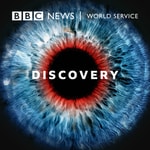Discovery – Détails, épisodes et analyse
Détails du podcast
Informations techniques et générales issues du flux RSS du podcast.


Explorations in the world of science.
Classements récents
Dernières positions dans les classements Apple Podcasts et Spotify.
Apple Podcasts
🇨🇦 Canada - science
09/08/2025#34🇬🇧 Grande Bretagne - science
09/08/2025#37🇩🇪 Allemagne - science
09/08/2025#85🇺🇸 États-Unis - science
09/08/2025#70🇫🇷 France - science
09/08/2025#87🇨🇦 Canada - science
08/08/2025#38🇬🇧 Grande Bretagne - science
08/08/2025#30🇩🇪 Allemagne - science
08/08/2025#78🇺🇸 États-Unis - science
08/08/2025#72🇨🇦 Canada - science
07/08/2025#30
Spotify
Aucun classement récent disponible
Liens partagés entre épisodes et podcasts
Liens présents dans les descriptions d'épisodes et autres podcasts les utilisant également.
See allQualité et score du flux RSS
Évaluation technique de la qualité et de la structure du flux RSS.
See allScore global : 33%
Historique des publications
Répartition mensuelle des publications d'épisodes au fil des années.
Sheila Willis
lundi 2 septembre 2024 • Durée 27:38
Dr Sheila Willis is a forensic scientist who was Director General of Forensic Science Ireland for many years.
She has spent her life using science to help solve cases, working on crime scenes and then analysing material in the lab, and presenting scientific evidence in court.
It’s a complicated business. Forensic science relies on powerful technology, such as DNA analysis, but it cannot be that alone - it’s also about human judgement, logical reasoning and asking the right questions.
It is these fundamentals of forensic science that Sheila has fought for through her long career and what she fears may be becoming lost from the field now.
We find out what happens when the two very different worlds of science and the law clash in the courtroom. How to walk the line of presenting scientific evidence where there is pressure to be definitive where often science cannot be - and what this part of the job has in common with food packaging.
And what makes a good forensic scientist?
We’ll turn the studio at London’s Broadcasting House into a live crime scene to see if host Professor Jim Al-Khalili would be any good as a forensic investigator…
The Life Scientific: Charles Godfray
lundi 26 août 2024 • Durée 27:36
Professor Charles Godfray, Director of the the Oxford Martin School tells Jim Al-Kahlili about the intricate world of population dynamics, and how a healthy obsession with parasitic wasps might help us solve some of humanity's biggest problems, from the fight against Malaria to sustainably feeding a global community of 9 billion people.
Fed: A Chicken and Egg Story
vendredi 5 juillet 2024 • Durée 26:28
So we started farming this bird called chicken, and it spread around the world. But what does it actually TAKE to feed us the amount of chicken we want to consume?
100 years ago this was a scrawny, egg-laying bird, only good for a stew once her eggs ran out – no one ate chicken meat. Fast forward to today and it’s the most consumed protein on the planet. How did we come to eat it in the first place, and what are the consequences of producing chicken meat on the vast, industrial scales we now consume it?
Dr Chris van Tulleken uncovers the extraordinary accident of history that birthed a new industry, and changed the way we eat – and think about – meat forever.
Wild inside: Great Grey Owl
lundi 28 novembre 2022 • Durée 27:14
One of the world’s large owls by length, the Great Grey Owl is an enigmatic predator of coniferous forests close to the Arctic tundra. It's most often seen hunting around dawn and dusk, when it perches silently at the edges of clearings. But as Prof Ben Garrod and Dr Jess French delve deep inside to understand its true secret to survival, they find the deep feathery coat belies a deceptively small head and body that‘s evolved unbelievably powerful abilities to silently detect and ambush unsuspecting prey.
Wild inside: The Cheetah
lundi 21 novembre 2022 • Durée 27:54
Zoologist Ben Garrod and veterinary surgeon Jess French delve deep into some amazing internal anatomy to unravel the secrets to survival of some of nature’s iconic animals.
They begin with one of the rarities of the cat family – the cheetah, which at just under two metres long, is the world’s fastest land animal capable of reaching speeds of up to 70mph in three seconds. As Ben and Jess reveal, the body’s rear muscles, large heart and nostrils enable it to achieve record breaking accelerations. But over long distances, it risks total exhaustion and predation from larger carnivores and the risk of losing its valuable prey. We hear during the course of this intricate dissection, how it treads a fine line between speed and stamina in the quest for survival.
The puzzle of the plasma doughnut
lundi 14 novembre 2022 • Durée 27:52
What do you get if you smash two hydrogen nuclei together? Helium and lots of energy – it's nuclear fusion!
Nuclear fusion is the power source of the sun and the stars. Physicists and engineers here on earth are trying to build reactors than can harness fusion power to provide limitless clean energy. But it’s tricky.
Rutherford and Fry are joined by Dr Melanie Windridge, plasma physicist and CEO of Fusion Energy Insights, who explains why the fourth state of matter – plasma – helps get fusion going, and why a Russian doughnut was a key breakthrough on the path to fusion power.
Dr Sharon Ann Holgate, author of Nuclear Fusion: The Race to Build a Mini Sun on Earth, helps our sleuths distinguish the more familiar nuclear fission (famous for powerful bombs) from the cleaner and much less radioactive nuclear fusion.
And plasma physicist Dr Arthur Turrell, describes the astonishing amount of investment and innovation going on to try and get fusion power working at a commercial scale.
The Riddle of Red-Eyes and Runny-Noses
lundi 7 novembre 2022 • Durée 28:50
Sneezes, wheezes, runny noses and red eyes - this episode is all about allergies.
An allergic reaction is when your immune system reacts to something harmless – like peanuts or pollen – as if it was a parasitic invader. It’s a case of biological mistaken identity.
Professor Judith Holloway from the University of Southampton guides our sleuths through the complex immune pathways that make allergies happen and tells the scary story of when she went into anaphylactic shock from a rogue chocolate bar.
Professor Adam Fox, a paediatric allergist at Evelina Children’s Hospital, helps the Drs distinguish intolerances or sensitivities – substantial swelling from a bee sting, for example - from genuine allergies. Hannah’s orange juice ‘allergy’ is exposed as a probable fraud!
Hannah and Adam explore why allergies are on the increase, and Professor Rick Maizels from the University of Glasgow shares his surprising research using parasitic worms to develop anti-allergy drugs!
Contributors: Professor Judith Holloway, Professor Adam Fox, Professor Rick Maizels
The problem of infinite Pi(e)
lundi 31 octobre 2022 • Durée 26:27
Pi is the ratio between a circle’s diameter and its circumference. Sounds dull – but pi turns out to have astonishing properties and crop up in places you would never expect. For a start, it goes on forever and never repeats, meaning it probably contains your name, date of birth, and the complete works of Shakespeare written in its digits.
Maths comedian Matt Parker stuns Adam with his ‘pie-endulum’ experiment, in which a chicken and mushroom pie is dangled 2.45m to form a pendulum which takes *exactly* 3.14 seconds per swing.
Mathematician Dr Vicky Neale explains how we can be sure that the number pi continues forever and never repeats - despite the fact we can never write down all its digits to check! She also makes the case that aliens would probably measure angles using pi because it’s a fundamental constant of the universe.
Nasa mission director Dr Marc Rayman drops in to explain how pi is used to navigate spacecraft around the solar system. And philosopher of physics Dr Eleanor Knox serves up some philoso-pi, revealing why some thinkers have found pi’s ubiquity so deeply mysterious.
The suspicious smell
lundi 24 octobre 2022 • Durée 28:17
Why are some smells so nasty and others so pleasant? Rutherford and Fry inhale the science of scent in this stinker of an episode.
Our sleuths kick off with a guided tour of the airborne molecules and chemical receptors that power the sense of smell. Armed with a stack of pungent mini-flasks, professor Matthew Cobb from the University of Manchester shows Hannah and Adam just how sensitive olfaction can be, and how our experience of some odours depends on our individual genetic make-up.
Dr Ann-Sophie Barwich from Indiana University reveals how most everyday smells are complex combinations of hundreds of odorants, and how the poo-scented molecule of indole turns up in some extremely surprising places.
With the help of a flavoured jellybean and some nose clips, Hannah experiences how smell is crucial to flavour, adding complexity and detail to the crude dimensions of taste.
Speaking of food, listener Brychan Davies is curious about garlic and asparagus: why do they make us whiff? Professor Barry Smith from the Centre for the Study of the Senses reveals it's down to sulphur-containing compounds, and tells the story of how a cunning scientist managed to figure out the puzzle of asparagus-scented urine.
Finally, another listener Lorena Busto Hurtado wants to know whether a person’s natural odour influences how much we like them. Barry Smith says yes - we may sniff each other out a bit like dogs - and cognitive neuroscientist Dr Rachel Herz points to evidence that bodily bouquet can even influence sexual attraction!
The Wild and Windy Tale
lundi 17 octobre 2022 • Durée 28:15
How do winds start and why do they stop? asks Georgina from the Isle of Wight. What's more, listener Chris Elshaw is suprised we get strong winds at all: why doesn't air just move smoothly between areas of high and low pressure? Why do we get sudden gusts and violent storms?
To tackle this breezy mystery, our curious duo don their anoraks and get windy with some weather experts.
Dr Simon Clark, a science Youtuber and author of Firmament, convinces Adam that air flow is really about the physics of fluids, which can all be captured by some nifty maths. The idea of pressure turns out to be key, so Hannah makes her own barometer out of a jar, a balloon and some chopsticks, and explains why a bag of crisps will expand as you walk up a mountain.
Professor Liz Bentley, Chief Executive of the Royal Meteorological Scoiety, reveals how the dynamics of a simple sea breeze – where air over land is heated more than air over water – illustrates the basic forces driving wind of all kinds.
Then everyone gets involved to help Adam understand the tricky Coriolis effect and why the rotation of the Earth makes winds bend and storms spin. And Professor John Turner from the British Antarctic Survey explains why the distinctive features of the coldest continent make its coastline the windiest place on earth.